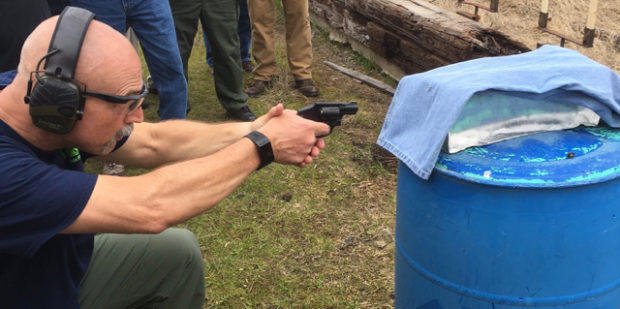Written by: Greg Ellifritz
During this year’s Rangemaster Tactical Conference, I attended an excellent class on handgun wound ballistics taught by Chuck Haggard of Agile Tactical. While Chuck shot a few service caliber loads during the gel testing portion of the class, he focused most of the time shooting loads from smaller caliber “backup” and “hideout” pistols. Ballistic testing is pretty common in service loads, but far less available for the guns most people actually carry. Chuck remedied this issue by testing many common defensive loads from .22, .32, and .38 snub revolvers as well as a couple .380 acp loads.
After the class ended, several of us “ballistic nerds” (Claude Werner, Tamara Keel, John Johnston, Chuck, and myself) stayed until sunset and shot a bunch of other loads.
All the rounds were shot into Chuck’s block of clear gelatin. This gelatin does not exactly duplicate the calibrated ballistic gelatin specified in the FBI’s ammunition testing protocols, but is far easier to make and store. Penetration tends to be a little deeper in the clear gelatin than in either ballistic gel or real bodies. The clear gel is best used to compare rounds to each other than to exactly duplicate a bullet’s performance in flesh.
When you see bullets pulled out of actual bodies, they rarely look like the perfectly mushroomed specimens shown by the bullet manufacturer’s sales literature. Often the bullets show incomplete (or no) expansion as well as significant deformation. Bullets pulled from bodies generally look like bullets shot into gelatin with heavy clothing covering than those shot into uncovered bare gelatin.
Keeping that in mind, Chuck placed four layers of denim over the gelatin block he shot into during the demonstration.. That little bit of material frustrated a lot of bullets.
The penetration results are as follows (all shot through heavy clothing)
.38 spl 110 grain +P+ JHP- 16″
.38 spl 125 grain Nyclad HP- 16″
.38 spl 148 grain lead wadcutter- 16″
.380 acp 95 grain Winchester Ranger T- 16″
.380 acp 90 grain Speer Gold Dot- 13″
.380 acp 90 grain jacketed flat point- 16″
.380 acp 90 grain Full Metal Jacket- 16″
9mm 124 grain Hornady Tap FD- 16″
9mm 124 grain Federal HST- 16″
The .38 loads were shot through a 2″ barrel J-frame
The .380 rounds were shot out of a Ruger LCP
The 9mm rounds were shot out of a Glock 43
You’ll notice that I didn’t provide any expansion data. That’s because NONE of the .380 or .38 special rounds expanded at all! All of the bullets except for the two 9mm rounds could have been reloaded and fired. They had no expansion whatsoever.
The Hornady 9mm load had some tip deformation that looked like half of the bullet expanded, but the other half remained in its original shape. The 9mm HST load expanded to about .60.
Many knowledgeable handgun instructors have noted that there really isn’t much significant difference in stopping power between most of the rounds people shoot at criminals. Is there any wonder? Look at the .38 and .380 rounds we tested. All penetrated the same distance and remained .35 caliber. Bullets with identical performance in gelatin should have similar performance in human bodies as well. It just doesn’t make much difference what round you carry in your “mouse guns.”
In addition to the above tests, we did some informal testing with .22 and .32 magnum snub nosed revolvers.
With the .22, we shot 32 grain CCI Stingers and 40 grain CCI Velocitors. Neither round expanded or deformed. The Stingers penetrated 14″-15″ in the clothing covered gelatin. The Velocitors penetrated 13″-14″.
Tamara shot several different .32 magnum loads out of her revolver. None of the loads expanded. All penetrated between 13″ and 16″.
The bottom line learning point for me was that one should not rely on a bullet’s expansion out of a short barreled pistol. When shot through clothing, all the bullets remained remarkably unchanged with no expansion whatsoever and penetrated to a similar depth.
Maybe we shouldn’t be arguing so much about caliber and bullet performance when there really isn’t much difference between carry loads. If you are carrying a .38 snub or a sub-caliber pistol. pick the load that is most reliable, accurate, and controllable in your particular carry gun. The bullets probably won’t expand. Rely on good shot placement instead of magical bullet construction to stop your attacker.


